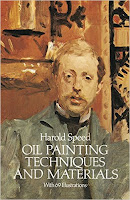I congratulate everyone who entered the "
Weed Painting Challenge." You braved heat, mosquitoes, midges, dead rats, and (potentially) alligators. Some of you painted outside for the first time or experimented with new media. Some just stepped out in the back yard, and others returned to the location many times.
It was hard to choose, but the Grand Prize Winner is Nic Human.
I was impressed by the attention he gave to the shapes of the petals, the orchestration of overlapping detail, the suggestion of depth through scale and value control, and the variety of greens.
He says: "This weed is called, Tithonia diversifolia, and it is more commonly known as the Mexican sunflower. I painted this in Pinetown, South Africa. It has become rampant in that area over the last couple of years. The big bright beautiful flowers are almost deceptive, because of the invasive nature of this weed."

"The painting media I used for this study were pen, travel watercolour and gouache onto cold pressed watercolour paper."
First among the five Finalists is Glenn Workshops who not only did a nice painting, but also returned to the site to do a whole series of studies.
He says, "My submission is of yellow hawkweeds (Hieracium caespitosum), a beautiful but invasive plant in British Columbia. It is painted in gouache on 5.5" x 7.5" Fabriano Artistico 140lb cold press paper. The drawing was sealed with an acrylic gloss gel medium which enables the gouache to be worked more like oils. The gouache can be easily "wiped" using water with a brush or cloth. One benefit of working this way is that an area (or the whole surface) can be scrubbed away to reveal the original drawing when repainting is required."

"Keeping with the inspiration of James' challenges I thought it would be interesting to limit myself to sketching in a single location and study only weeds and their habitat for the duration of this challenge. A near-by vacant lot, overgrown with weeds, became my studio. It's amazing at how much there is to observe within a single field. Colours that appear and disappear over the course of a day, shapes and groupings that move and morph, the behaviour patterns of various plants, plus the insects and wasps tending to the plants. Below are some of the studies done during this month."
"This one has really helped me to get out more and push myself in different areas; a true challenge. Thanks James."
The next finalist is Greg Preslicka, who did a great job of value control in the large masses of foliage, setting up perfectly for the light pinks of the flowers.
"Crown Vetch (Coronilla varia), Casein, 7"x10"
"These are in full bloom here in Minnesota. They add nice color to most ditches. Found out after I painted this that it is considered an invasive species. It was introduced to the state for erosion control in construction areas. Now it is a little out of control. Kind of pretty though."
Ian Bosworth is our next winner with a lyrical study of an overgrown patch of weeds. "Hi, this is a spot at the side of my local reservoir. I noticed it when I was having a run around it."
"There was a gap in the canopy of the trees that was letting the light flood in to this spot which was rather nice. First time I have used the umbrella as the Cornish drizzle started to set in I still got soaked through though."
Next finalist is Karl Wennergren, with a sweeping Swedish landscape.
"I chose to paint this field of Bunias orientalis. I set out to paint in the forest originally but right before I entered the tree line I turned around. What first attracted me was how the path disappeared into the field with a nice curve and I thought it would be fun challenge to try and simplify the weeds while keeping a strong shape design. Before I started painting I had to get rid of a huge dead rat that was lying exactly where I decided to set up and was attracting a ton of flies."

"Oil on canvas, colors: Ultramarine blue, Burnt umber, Alizarin permanent, Cadmium red, Cadmium yellow and Titanium white."
And finally, Pascal Miller found some weeds clinging to the side of a building in France. "Gouache & watercolor pencils 5.8'' x 8.3"
"I was in Valenciennes in the north of France, and spotted what used to be an old print shop. Burned down and abandoned for several years, it had a magnificent weed of some sort sprouting from the side of the building. I couldn't identify the species of plant."















































